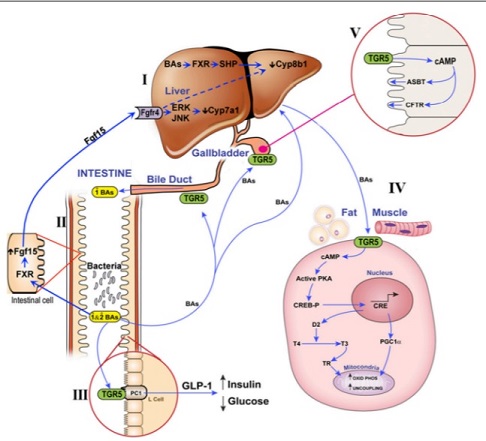
MOLECULAR REGULATION OF BILE ACID HOMEOSTASIS

ABSTRACT
Bile acids have been known for decades to aid in the digestion and absorption of dietary fats and fat soluble vitamins in the intestine. The development of gene knockout mice models and transgenic humanized mouse models have helped us understand other function of bile acids, such as their role in modulating fat, glucose, and energy metabolism, and in the molecular regulation of the synthesis, transport, and homeostasis of bile acids. The G-protein coupled receptor TGR5 regulates the bile acid induced alterations of intermediary metabolism, while the nuclear receptor FXR regulates bile acid synthesis and homeostasis. However, this review indicates that unidentified factors in addition to FXR must exist to aid in the regulation of bile acid synthesis and homeostasis
SIGNIFICANCE STATEMENT
This review captures the present understanding of bile acid synthesis, the role of bile acid transporters in the enterohepatic circulation of bile acids, the role of the nuclear receptor FXR on the regulation of bile acid synthesis and bile acid transporters, and the importance of bile acids in activating GPCR signaling via TGR5 to modify intermediary metabolism. This information is useful for developing drugs for the treatment of various hepatic and intestinal diseases, as well as the metabolic syndrome.
By: Supratim Choudhuri and Curtis D. Klaassen
Read More: https://pubmed.ncbi.nlm.nih.gov/34686523/
| Last modified: | 30 October 2021 8.27 p.m. |
More news
-
16 December 2024
Jouke de Vries: ‘The University will have to be flexible’
2024 was a festive year for the University of Groningen. In this podcast, Jouke de Vries, the chair of the Executive Board, looks back.
-
10 June 2024
Swarming around a skyscraper
Every two weeks, UG Makers puts the spotlight on a researcher who has created something tangible, ranging from homemade measuring equipment for academic research to small or larger products that can change our daily lives. That is how UG...
